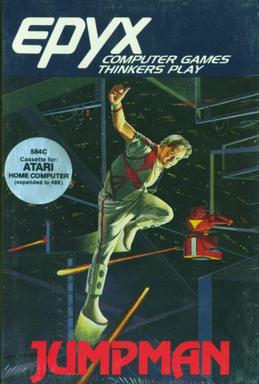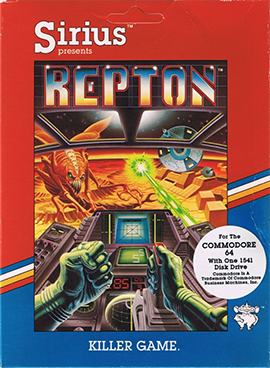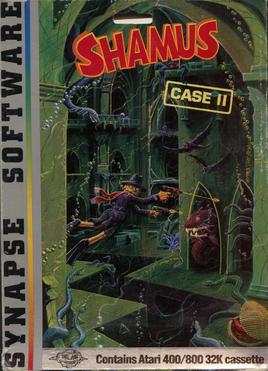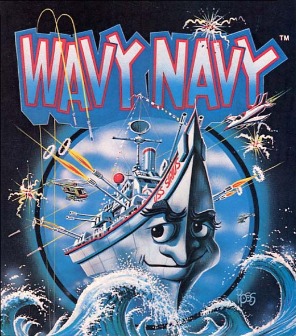
Jumpman is a platform game written by Randy Glover and published by Epyx in 1983. It was developed for the Atari 8-bit computers, and versions were also released for the Commodore 64, Apple II, and IBM PC compatibles.

Zaxxon is a scrolling shooter developed and released by Sega as an arcade video game in 1982. The player pilots a ship through heavily defended space fortresses. Japanese electronics company Ikegami Tsushinki was also involved in the game's development.

Choplifter is a military themed scrolling shooter developed by Dan Gorlin for the Apple II and published by Broderbund in 1982. It was ported to Atari 8-bit computers the same year and also to the VIC-20, Commodore 64, Atari 5200, ColecoVision, MSX, and Thomson computers.

Shamus is a shooter with light action-adventure game elements written by Cathryn Mataga and published by Synapse Software. The original Atari 8-bit computer version was released on disk and tape in 1982. According to Synapse co-founder Ihor Wolosenko, Shamus made the company famous by giving it a reputation for quality. "Funeral March of a Marionette", the theme song from Alfred Hitchcock Presents, plays on the title screen.

Repton is a Defender-inspired scrolling shooter written by Dan Thompson and Andy Kaluzniacki for the Apple II and published by Sirius Software in 1983. It was ported to the Atari 8-bit computers, and Commodore 64.
Synapse Software Corporation was an American software developer and publisher founded in 1981 by Ihor Wolosenko and Ken Grant. Synapse published application software and developer tools and was primarily known for video games. It initially focused on the Atari 8-bit computers, then later developed for the Commodore 64 and other systems. Synapse was purchased by Broderbund in late 1984 and the Synapse label retired in 1985.

Crossfire is a multidirectional shooter created by Jay Sullivan for the Apple II and published by On-Line Systems in 1981. Using keyboard-based twin-stick shooter controls, the player maneuvers a ship in a grid-like maze. Versions with joystick-control use the stick for movement and switch to firing mode when the button is held down.

Gateway to Apshai is an action-adventure game for the Commodore 64, ColecoVision and Atari 8-bit computers. It was developed by The Connelley Group and published by Epyx in 1983 as a prequel to Temple of Apshai. It is a more action-oriented version of Temple of Apshai, with smoother and faster graphics, streamlined controls, fewer role-playing video game elements, and fewer room descriptions.

Fort Apocalypse is a multidirectional scrolling shooter for Atari 8-bit computers created by Steve Hales and published by Synapse Software in 1982. Joe Vierra ported it to the Commodore 64 the same year. The player navigates an underground prison in a helicopter, destroying or avoiding enemies and rescuing prisoners. A contemporary of Choplifter, it has similarities to that game as well as the arcade games Scramble and Super Cobra.

Dropzone is a horizontally scrolling shooter developed by Archer Maclean for Atari 8-bit computers and published in 1984 by U.S. Gold. It was ported to the Commodore 64, and later released for the Nintendo Entertainment System, Game Boy, Game Gear, and Game Boy Color.

Panther is a Commodore 64 game designed and implemented by Peter Adams and published by Mastertronic in 1986. A version for Atari 8-bit computers followed in 1987, then a ZX Spectrum port in 1989. The player pilots a strange-looking aircraft, fighting off hordes of invading flying saucers and rescuing people by landing the craft and waiting for them to board. The game uses a diagonally scrolling isometric view, much like Zaxxon and Blue Max, using shadows to show the height of flying objects. Adams previously worked on ports of both of those games.

Gridrunner is a fixed shooter video game written by Jeff Minter and published by Llamasoft for the VIC-20 in 1982. It was ported to the Atari 8-bit computers, ZX Spectrum, Commodore 64, Commodore PET and Dragon 32. Many remakes and sequels have followed, including versions for the Atari ST, Amiga, Pocket PC, Microsoft Windows, and iOS.

Blue Max 2001 is a diagonally-scrolling shooter written by Bob Polin for Atari 8-bit computers and published by Synapse Software in 1984. A Commodore 64 version was released the same year. Blue Max 2001 is the sequel to 1983's Blue Max, also by Polin, with the player piloting a futuristic hovercraft instead of a World War I biplane. Critics found the game disappointing compared with the original, citing the indistinct graphics and confusing documentation.

Shamus: Case II is a 1983 video game for Atari 8-bit computers written by Cathryn Mataga and published by Synapse Software. Mataga also wrote the original Shamus and the scrolling shooter Zeppelin. A port to the Commodore 64 by Joe Vierra was released in 1984. Although ostensibly a sequel to Shamus, the gameplay is very different, combining aspects of platform games, maze games, and even Breakout. Case II was as well received as the original.

Dimension X is a first person action game for Atari 8-bit computers released in 1984 by Synapse Software. It was designed by Steve Hales, who previously wrote Slime and Fort Apocalypse for Synapse. Dimension X is a vehicle-based, first person shooter with similar gameplay to Atari's Battlezone and Novagen's Encounter. The manual includes instructions for a Commodore 64 version of the game, but it was never completed nor released.

Bandits is a 1982 fixed shooter written by Tony and Benny Ngo for the Apple II and published by Sirius Software. The game is a clone of Taito's 1980 Stratovox arcade video game where the goal is to prevent aliens from stealing objects. Bandits was ported to the Atari 8-bit computers, Commodore 64, and VIC-20.

Wavy Navy is a video game designed by Rodney McAuley for the Apple II and published by Sirius Software in 1983. Versions for the Atari 8-bit computers and Commodore 64 were released the same year. Wavy Navy is a nautically themed fixed shooter with left and right controls to move the player's PT boat, but there is an additional vertical element as the boat moves up and down with the large ocean waves that scroll beneath it. The direction and speed of the waves vary per level. Some reviewers found that the movement of the waves added an interesting twist, while others called it too similar to other fixed shooters like Galaxian.

Nightraiders is a vertically scrolling shooter designed by Peter Filiberti and published in 1983 by Datamost for Atari 8-bit computers. It is heavily inspired by the 1982 Sega arcade video game Zaxxon.

Zeppelin is a multidirectional scrolling shooter designed by Cathryn Mataga and published in 1983 by Synapse Software for Atari 8-bit computers. A Commodore 64 port programmed by David Barbour was released in 1984.




















